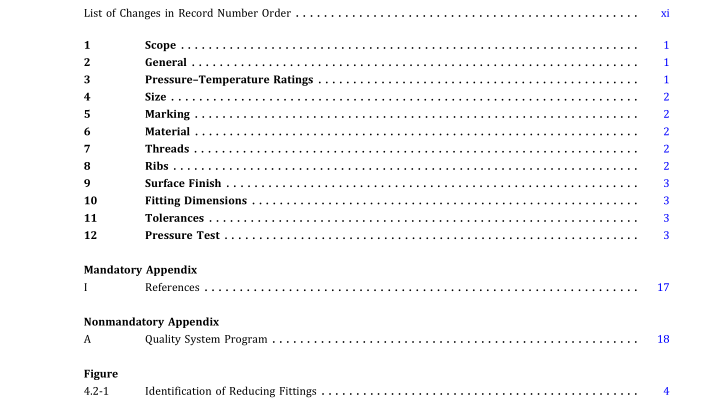ASME B16.15-2018 pdf free download.Cast Copper Alloy Threaded Fittings Classes 125 and 250
3.3 Limitations Use ofcored plugs and hexagon or octagon head bushingsshouldbelimitedtoClass125 pipefittings.Solidplugs and face bushings are recommended for use with Class 250 pipe fittings.
4 SIZE
4.1 ð18Þ Nominal Pipe Size The size of the pipe fittings scheduled in the tables herein is identified by the corresponding nominal pipe size (NPS).1
4.2 Reducing Sizes In the case of reducing tees, crosses, and Y branches (laterals), the NPS of the largest run opening shall be givenfirst, followed bythe NPS ofthe openingatthe oppo- site end of the run. Where the pipe fitting is a tee or Y branch (lateral), the NPS of the outlet is given last. Where the pipe fitting is a cross, the largest side-outlet opening is the third dimension given, followed by the opening opposite. The straight line sketches of Figure 4.2-1 illustrate how the reducing pipe fittings are read.
5 MARKING
5.1 Class 125 Fitting Each Class 125 pipe fitting shall be marked for identification with the manufacturer’s name or trademark.
5.2 Class 250 Fitting Each Class 250 pipe fitting shall be marked for identification with the manufacturer’s name or trademark and the numerals “250.” 5.3 Exceptions Omission of markings is permissible when fittings are too small to provide sufficient marking area.
6 MATERIAL (a) Castings shall be produced to meet the require- ments of ASTM B62, alloy UNS C83600, or the chemical and tensile requirements of ASTM B584, alloys UNS C83800 or UNS C84400, and in all other respects shall conform to the requirements of ASTM B62. (b) Bar stock, when used for manufacturing smaller sizes of wrought plugs, bushings, caps, and couplings, shall be in accordance with the requirements of ASTM B16, alloy UNS C36000, or ASTM B140, alloy UNS C32000 or UNS C31400. 7 THREADS 7.1 Thread Form All threads shall be in accordance with ASME B1.20.1.
7.1.1 Countersinks and Chamfers. All internal taper pipethreadsshallbecountersunkorchamferedadistance notless than one-halfthe pitch ofthe thread atan angle of approximately45 degwith the axis ofthe thread. External taperpipe threads shall be chamferedatanangle between 30 deg and 45 deg with the axis for easier entrance in making a j oint and protection of the thread. Countersinking and chamfering shall be concentric with the threads. The length of threads specified in all tables shall be measured to include the countersink or chamfer.
7.1.2 Alignment. The maximum allowable variation in thealignmentofthreadsofallopeningsshallbe5.0 mm/m (0.06 in./ft).
7.1.3 Internal Threading (a) All fittings with internal threads except as allowed in (b) shall be threaded with ASME B1.20.1 NPT threads. The reference point for gaging is the starting end of the fitting, provided the chamfer does not exceed the major diameter of the internal thread. When a chamfer on the internal thread exceeds this limit, the reference point becomes the last thread scratch on the chamfer cone. (b) Wrought couplings (Table 7.1.3-1), wrought caps (Table 7.1.3-2), and wrought bushings (Table 7.1.3-3) in sizes NPS 1 ∕ 8 , NPS 1 ∕ 4 , NPS 3 ∕ 8 , and NPS 1 ∕ 2 shall have NPT or NPSC internal threads.
7.1.4 External Threading. All externally threaded fittings shall be threaded with ASME B1.20.1 NPT threads. The reference point for gaging is the end of the thread, provided the chamfer is not smaller than the minor diameter of the external thread. When a chamfer on the external thread exceeds this limit, the reference point becomes the last thread scratch on the chamfer cone.
7.2 ð18Þ Gaging Tolerances For taper pipe threads, the variation in threading shall be limited to one turn large or one turn small from the gaging notch on the plug or the gaging face of the ring when using working gages. For straight pipe threads, the variation in threading shall be limited to 1 1 ∕ 2 turns large or 1 1 ∕ 2 turns small from the gaging notch on the plug when using working gages.
8 RIBS The addition of ribs or lugs is permitted on threaded pipe fittings. Where ribs are used, it is recommended that their thickness be the same as specified for the metal thickness of the pipe fitting.ASME B16.15 pdf download.ASME B16.15-2018 pdf free download
